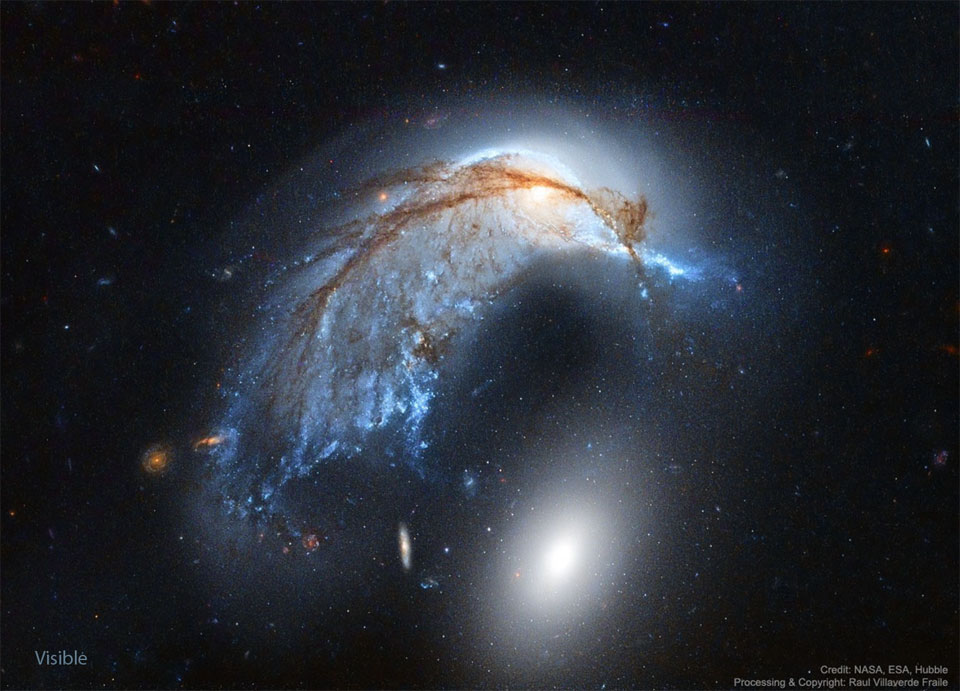Blog
Toumani Diabaté (10 August 1965 – 19 July 2024) was a Malian kora player. In addition to performing the traditional music of Mali, he was involved in cross-cultural collaborations with flamenco, blues, jazz, and other international styles of music. In 2006, the London-based newspaper The Independent named him one of the fifty best African artists. In its obituary, The Timesdescribed him as “a bold and innovative musical visionary”.
more...Sh2-129 (R.A.: 21h 12m 20.24s, Dec: +60º 02’ 15.1”) is a Bright Nebula of Visual Magnitude 10 in the constellation Cepheus at a distance of 9318 lightyears from Earth. It is one of the many beautiful H-alpha emitting objects that can be found in the Sharpless catalogue. The nebula is also known as Flying Bat Nebula. Interestingly, at the heart of the nebula, there is another nebula located, often referred to as Flying Squid Nebula (Ou4). This OIII emitting nebula was only recently discovered by the French amateur astrophotographer Nicolas Outters in 2011. Recent research seems to indicate that Ou4 is indeed located within Sh2-129. It is assumed that the nebula is getting it’s energy from a strong outflow from HR8119, a triple star system right in the middle of the Flying Squid Nebula.

Saskia Laroo (born 31 July 1959 in Amsterdam), is a Dutch jazz musician who has been dubbed the “Lady Miles Davis“. Her music style can be described as a combination of jazz, pop, electronic dance music, Latin and world music.
more...Stanley Jordan (born July 31, 1959) is an American jazz guitarist noted for his playing technique, which involves tapping his fingers on the fretboard of the guitar with both hands.
Jordan was born in Chicago, Illinois, United States. When he was six, he started on piano, then at eleven switched to guitar. He later began playing in rock and soul bands. In 1976, he won an award at the Reno Jazz Festival. At Princeton University, he studied music theory and composition with Milton Babbitt and computer music with Paul Lansky. He also took freshman calculus with Edward Nelson. While at Princeton he played with Benny Carter and Dizzy Gillespie.
more...Kenneth Earl Burrell (born July 31, 1931 Detroit, MI) is an American jazz guitarist known for his work on numerous top jazz labels: Prestige, Blue Note, Verve, CTI, Muse, and Concord. His collaborations with Jimmy Smith were notable, and produced the 1965 Billboard Top Twenty hit Verve album Organ Grinder Swing. He has cited jazz guitarists Charlie Christian, Oscar Moore, and Django Reinhardt as influences, along with blues guitarists T-Bone Walker and Muddy Waters.
Burrell is a professor and Director of Jazz Studies at the UCLA Herb Alpert School of Music.
more...Henry Jones Jr. (July 31, 1918 – May 16, 2010 Vicksburg, MS) was an American jazz pianist, bandleader, arranger, and composer. Critics and musicians described Jones as eloquent, lyrical, and impeccable. In 1989, The National Endowment for the Artshonored him with the NEA Jazz Masters Award. He was also honored in 2003 with the American Society of Composers, Authors, and Publishers (ASCAP) Jazz Living Legend Award. In 2008, he was awarded the National Medal of Arts. On April 13, 2009, the University of Hartford presented Jones with an honorary Doctorate of Music for his musical accomplishments.
Jones recorded more than 60 albums under his own name, and countless others as a sideman, including Cannonball Adderley‘s celebrated album Somethin’ Else. On May 19, 1962, he played piano as actress Marilyn Monroe sang her famous “Happy Birthday, Mr. President” song to then U.S. president John F. Kennedy
more...Susana Maria Alfonso de Aguiar (18 June 1955 – 27 July 2024), known mononymously as Mísia, was a Portuguese fado singer. She was a polyglot, singing some of her songs in Spanish, French, Catalan, English, and Japanese.
Mísia’s mother was Catalan and used to be a cabaret dancer, which accounts for many of the influences that shaped her music: tango, bolero, the use of Portuguese guitar with accordion, violin and the piano.
Mísia died from cancer at a hospital in Lisbon, on 27 July 2024, at the age of 69.
more...
Two big galaxies interacting. Just a few hundred million years ago, the upper NGC 2936 was likely a normal spiral galaxy: spinning, creating stars, and minding its own business. Then it got too close to the massive elliptical galaxy NGC 2937, below, and took a dive. Together known as Arp 142, they are featured in this new Webb infrared image, while a visible light Hubble image appears in comparison. NGC 2936 is not only being deflected, but distorted, by this close gravitational interaction. When massive galaxies pass near each other, gas is typically condensed from which new stars form. A young group of stars appears as the nose of the penguin toward the right of the upper galaxy, while in the center of the spiral, bright stars together appear as an eye. Before a billion years, the two galaxies will likely merge into one larger galaxy. 326mly.

David William Sanborn (July 30, 1945 – May 12, 2024 Tampa, FL) was an American alto saxophonist. Sanborn worked in many musical genres; his solo recordings typically blended jazz with instrumental pop and R&B. He began playing the saxophone at the age of 11 and released his first solo album, Taking Off, in 1975. He was active as a session musician, and played on numerous albums by artists including Stevie Wonder, Bruce Springsteen, Aretha Franklin, Sting, the Eagles, Rickie Lee Jones, James Brown, George Benson, Carly Simon, Elton John, Bryan Ferry and the Rolling Stones. He released more than 20 albums and won six Grammy awards.
Sanborn was one of the most commercially successful American saxophonists to earn prominence since the 1980s. He was described by critic Scott Yanow as “the most influential saxophonist on pop, R&B and crossover players of the past 20 years.” He became identified with radio-friendly smooth jazz, although he disliked the term and said he was not a jazz musician.
more...James Chambers, OM (born 30 July 1944), known professionally as Jimmy Cliff, is a Jamaican ska, rocksteady, reggae and soul musician, multi-instrumentalist, singer, and actor. He is the only living reggae musician to hold the Order of Merit, the highest honour that can be granted by the Jamaican government for achievements in the arts and sciences.
Cliff is best known among mainstream audiences for songs such as “Many Rivers to Cross“, “You Can Get It If You Really Want“, “The Harder They Come“, “Reggae Night“, and “Hakuna Matata“, and his covers of Cat Stevens‘s “Wild World” and Johnny Nash‘s “I Can See Clearly Now” from the film Cool Runnings. He starred in the film The Harder They Come, which helped popularize reggae around the world, and Club Paradise. Cliff was one of five performers inducted into the Rock and Roll Hall of Fame in 2010.
more...Vernel Anthony Fournier (July 30, 1928 – November 4, 2000), known from 1975 as Amir Rushdan, was an American jazz drummer probably best known for his work with Ahmad Jamalfrom 1956 to 1962.
Fournier was born in New Orleans, Louisiana, into a Creole family. He left college to join a big band led by King Kolax. After Kolax downsized to a quintet, Fournier moved to Chicago in 1948,where he played with such musicians as Buster Bennett, Paul Bascomb and Teddy Wilson. As house drummer at the Bee Hive club on Chicago’s South Side in 1953–55, he accompanied many visiting soloists, including Lester Young, Ben Webster, Sonny Stitt, J.J. Johnson, Earl Washingtonand Stan Getz.
From 1953 to 1956, Fournier also worked many recording sessions with Al Smith, Red Holloway, Lefty Bates, and others. He joined Ahmad Jamal’s trio in 1957, along with bass player Israel Crosby, and remained with the group until 1962, appearing on a series of recordings for the Chesslabel. The best known of these, At the Pershing: But Not for Me (1958), became one of the best selling jazz records of all time, remaining on the Billboard jazz charts for over two years.
After leaving the Jamal trio, Fournier joined George Shearing for two years before rejoining Jamal briefly in 1965–66. He then took a long-running gig with a trio at a restaurant owned by Elijah Muhammad.
more...George “Buddy” Guy (born July 30, 1936 Lettsworth, LA) is an American blues guitarist and singer. He is an exponent of Chicago blues who has influenced generations of guitarists including Eric Clapton, Jimi Hendrix, Jimmy Page, Keith Richards, Stevie Ray Vaughan, Jeff Beck, Gary Clark Jr. and John Mayer. In the 1960s, Guy played with Muddy Watersas a session guitarist at Chess Records and began a musical partnership with blues harp virtuoso Junior Wells.
Guy has won eight Grammy Awards and a Lifetime Achievement Award, the National Medal of Arts, and the Kennedy Center Honors. Guy was ranked 27th in Rolling Stonemagazine’s 2023 list of greatest guitarists of all time. His song “Stone Crazy” was ranked 78th in the Rolling Stone list of the “100 Greatest Guitar Songs of All Time”.Clapton once described him as “the best guitar player alive”. In 1999, Guy wrote the book Damn Right I’ve Got the Blues, with Donald Wilcock. His autobiography, When I Left Home: My Story, was published in 2012.
more...More Posts
- The Cosmos with NGC 4680
- Derek Trucks
- Bill Watrous
- World Music Memorial Alfonso Paredes ‘Niño Alfonso’
- Daily Roots with King Tubby & the Aggrovators
- The Cosmos with Nova Cas 2021
- Prince
- Beryl Booker
- Tina Brooks
- Tal Farlow
- World Music with YUNIS
- Daily Roots with Simple Simon
- The Cosmos with M42
- Monty Alexander
- Grant Green
- Jimmie Lunceford
- World Music with Seun Kuti and Egypt 80
- Daily Roots with Jimmy Riley
- Diego LaBriola Memorial 2021
- The Cosmos with NGC 578


